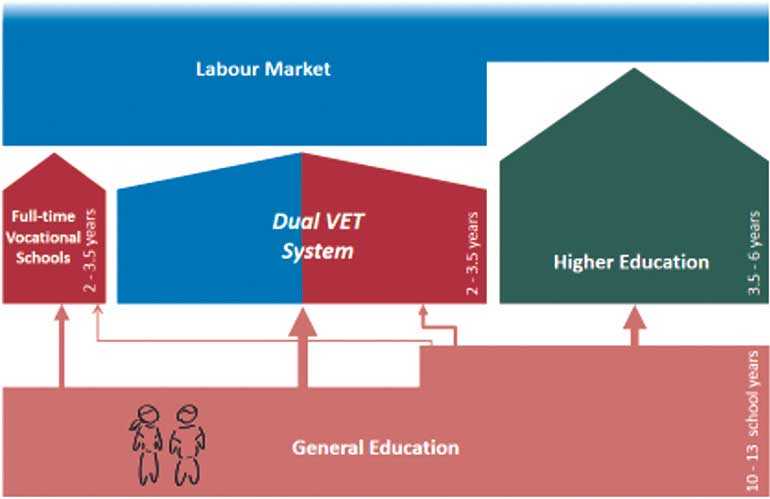Friday Apr 19, 2024
Friday Apr 19, 2024
Monday, 22 April 2019 00:10 - - {{hitsCtrl.values.hits}}

 By Marianne David
By Marianne David
The beauty of the German dual vocational education and training system lies not only its structure and many prospective paths, but also in how it empowers all stakeholders and unites them towards a common cause of education with purpose.
While it is highly structured, it is certainly not rigid – it flows in a seemingly effortless manner in many directions, enabling young adults and adults alike to make choices in line with their life goals and employment options as and when required.
Ensuring low unemployment
Competence is a key focus, instead of learning for the sake of learning, and the system goes a long way in ensuring low unemployment among youth in the country.
According to the ‘World Social and Employment Outlook – Trends 2018’ report prepared by the ILO, young people under the age of 25 are less likely to find work than adults and the global youth unemployment rate stands at 13%, three times higher than the figure for adults, which is 4.3%.
However, according to information released by the DGB – The Confederation of German Trade Unions attached to the German Education Policy Department – the youth unemployment rate in Germany has remained low by international comparison. With buy-in by all stakeholders who take great pride in its success, the system has been in place for several decades and is continually fine-tuned, ensuring an up-to-date and relevant offering.
Why dual?
At present around 1.6 million young people are undertaking dual vocational training in Germany.
The system is termed dual for a simple reason, the training takes place in two learning institutions – a company and a vocational training college – with courses usually lasting between three and three-and-a-half years.
The training is geared towards equipping young people with the qualifications and skills they need to adapt to a changing working environment through a structured training course.
The DGB emphasised that the dual training enables employees to face up to changes in the working environment and the accompanying destabilisation of labour relations resulting from workers changing employers and moving into other professions more frequently, as well as from the increasing number of temporary workers, and so on, asserting that the broad-based, non-specialist initial vocational training is the foundation for successful integration into society and the working world.
The in-company training component of dual vocational training courses provides students with first-class professional qualifications, ensuring that a high percentage of trainees find employment on the labour market.
Currently more than half of any given year’s group of students successfully complete their dual vocational training course and very few other European countries manage to get as many young people into the labour market as Germany does through this system.
Specific training
Students who successfully complete such a course have the skills needed for a profession as a skilled worker in one of approximately 345 occupations requiring formal training.
The training starts after public school (formally no school leaving certificate required) and requires a contract with a company, while the apprentices are also paid a ‘salary’ during their apprenticeship, making the system even more attractive.
“The standout feature of dual vocational training is that it aims to train students to do a specific job. After finishing their vocational training, the trained skilled workers have the requisite qualifications – as defined in the relevant occupational profile – needed to perform a specific occupation. Students are deemed to have the skills needed to perform the job if they pass a final examination testing both vocational knowledge and know-how,” stated the DBG. It comes as no surprise then that many other countries are looking to introduce systems similar to the dual training system, with the aim of achieving better interaction between education and employment systems, reducing youth unemployment, and strengthening companies by supplying the next generation of skilled workers.
Challenges
The system is not without its challenges, despite continuous fine-tuning.
A key challenge at present is the shortage of teachers, another is equipping schools digitally to offer e-learning, and an inclusion project for joint learning is a challenge that requires teachers with special competencies.
Educating and integrating the large numbers of refugees in Germany into normal school is also a key challenge while the increasing tendency to choose the academic pathway is also of concern.
Secret of success
A key message that is repeated by stakeholders when speaking about the German dual vocational education and training system is this: “There is only one thing more important than education. That is more education.”
However, the principle of work-based learning is key and therein lies the secret of the system’s enduring success.
(The Daily FT participated in a programme on Dual Vocational Education and Training in Germany at the invitation of the Federal Foreign Office in March this year.)